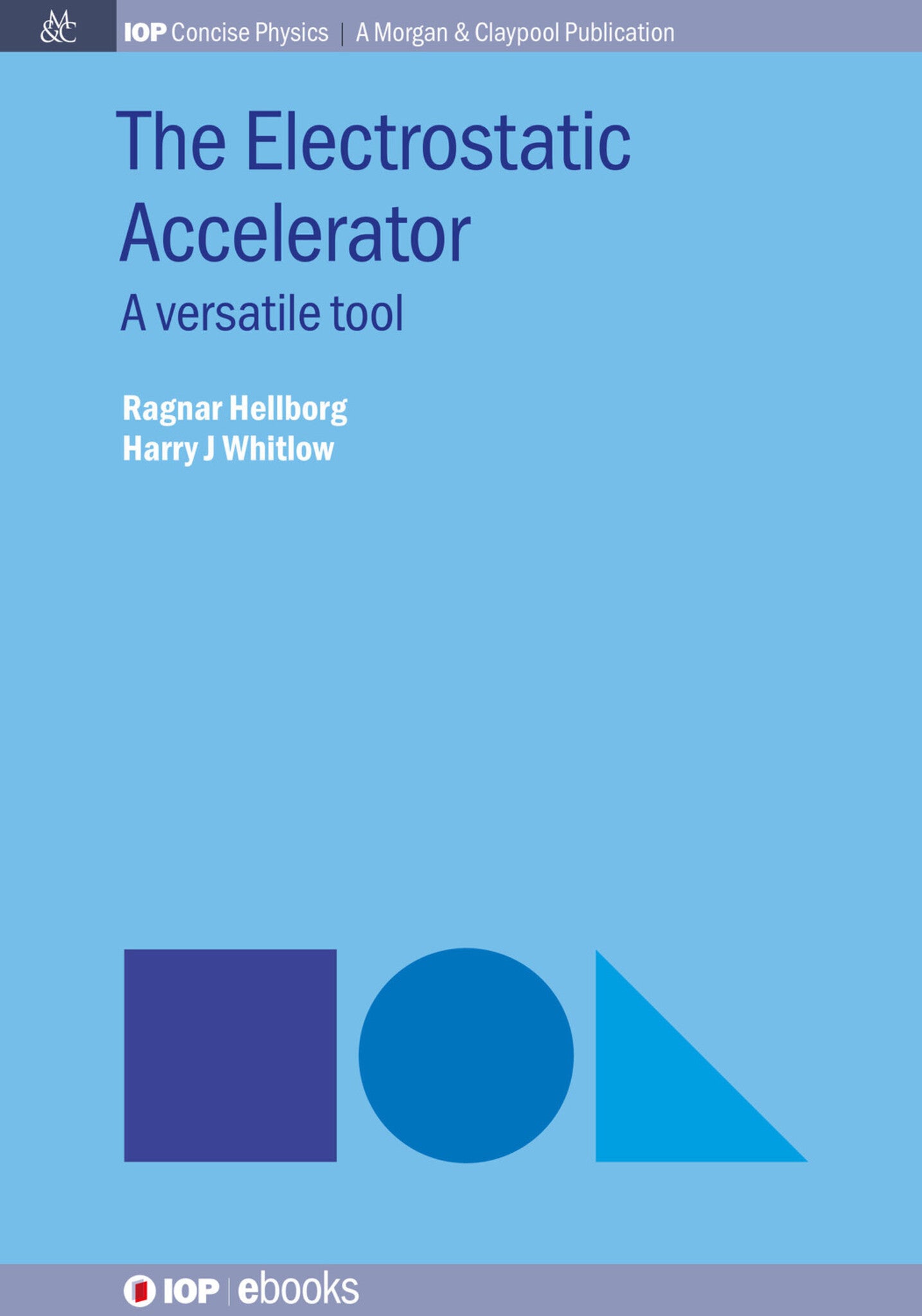We're sorry. An error has occurred
Please cancel or retry.
The Electrostatic Accelerator

Some error occured while loading the Quick View. Please close the Quick View and try reloading the page.
Couldn't load pickup availability
- Format:
-
08 March 2019

Electrostatic accelerators have been at the forefront of modern technology since the development of the first accelerator by Sir John Cockroft and Ernest Walton in 1932. Theirs was the first to achieve nuclear transmutation and earned them the Nobel Prize in Physics in 1951. The applications of Cockroft and Walton’s development have been far-reaching, even into our kitchens where it is employed to generate the high voltage needed for the magnetron in microwave ovens. Other electrostatic accelerator related Nobel prize-winning developments that have had a major socio-economic impact are the electron microscope, X-rays, computer tomography (CT) scanners and microelectronic technology where ion implantation is used to dope the semiconductor chips which form the basis of our computers, mobile phones and entertainment systems. Although the electrostatic accelerator field is more than 90 years old, and only a handful of accelerators are used for their original purpose in nuclear physics, the field and the number of accelerators is growing more rapidly than ever. The objective of this book is to collect together the basic science and technology that underlies the electrostatic accelerator field so it can serve as a reference guide and textbook for accelerator engineers as well as students and researchers who work with electrostatic accelerators.

SCIENCE / Physics / Atomic & Molecular, SCIENCE / Physics / Nuclear, SCIENCE / Physics / Quantum Theory

Bibliography 1 Introduction Bibliography 2 The field of accelerator techniques 2.1 Different types of accelerator 2.2 Orbital accelerators 2.2.1 Cyclotrons 2.2.2 Synchrocyclotrons and Isochronous Cyclotrons 2.2.3 Synchrotrons 2.3 Linear Accelerators 2.4 Direct voltage accelerators 2.5 Tandem electrostatic accelerator Bibliography 3 History of electrostatic accelerators 3.1 Development of Van de Graaff accelerators 3.2 The Herb Accelerators 3.3 Commercially produced accelerators 3.4 The development of tandem accelerators 3.5 The big machines Bibliography 4 Electrostatics 4.1 Field Distributions 4.2 Potential dividers Bibliography 5 Insulating gases Bibliography 6 Charging systems 6.1 Belt charging systems 6.2 Chain charging systems 6.3 Cascade generator charging systems Bibliography 7 Voltage Distribution Systems 7.1 Corona point systems 7.2 Resistor chains Bibliography 8 High Voltage Stabilisation 8.1 Feedback voltage stabilisation 8.1.1 Voltage multiplier-high voltage supplies 8.1.2 Stabilisation of chain- and belt-charged accelerators Bibliography 9 Accelerator Tubes 9.1 Beam optics Bibliography 10 Ion Stripper System and Terminal Pumping 10.1 Charge exchange 10.1.1 Foil strippers 10.1.2 Gas strippers 10.1.3 Terminal pumping Bibliography 11 Electron sources 11.0.1 Thermionic emission 11.0.2 Thermionic emission of electrons from a surface 11.0.3 Field emitters 11.0.4 Plasma electron sources 11.0.5 Photoelectric electron emission 11.1 Thermionic electron gun 12 Positive Ion Sources 12.1 RF-ion sources 12.2 Penning Ion Sources 12.3 Duoplasmatron Ion Sources Bibliography 13 Negative Ion Formation Processes and Sources 13.1 Negative ion formation 13.1.1 Direct extraction from gaseous plasma 13.1.2 Negative-ion formation through charge exchange 13.1.3 Sputter-ion sources as a source of negative ions Bibliography 14 Equipment for Beam Diagnostics 14.1 Measurement of the Beam Current 14.2 Monitoring the Beam Diameter and Position 14.3 Beam Profile Monitors 14.4 Beam Stoppers and Safety Equipment Bibliography 15 Charged Particle Optics and Beam Transport 15.1 Specification of the ion beam 15.1.1 Beam currents, fluxes and fluence 15.2 Charge particle beam optics and beam transport characteristics for different types of end-station beam-lines 15.3 Accelerator ion optics 15.3.1 Particle acceleration and the Lorentz equation 15.3.2 The drift section 15.3.3 Electrostatic acceleration 15.3.4 Electrostatic deflection 15.3.5 Magnetic dipole 15.3.6 Magnetic quadrupoles Bibliography 16 Radiation Protection at an Accelerator Laboratory 16.1 Types of radiation 16.1.1 Interactions of accelerator-induced radiation with matter 16.2 Radiation dosimetry 16.3 Detecting Ionising Radiation Bibliography 17 Computer control of accelerators 17.1 Introduction 17.2 Distributed intelligence 17.2.1 GUI design 17.2.2 Interlock design 17.3 Smart Accelerators and Industrie 4.0 17.4 Obsolescence considerations 17.4.1 Control system security Bibliography 18 Vacuum technology for electrostatic accelerators 18.1 Introduction 18.2 Basic high vacuum technology 18.3 Kinetic theory and gas flow in vacuum systems 18.3.1 Differential pumping 18.4 Vacuum components 18.4.1 Vacuum pumps 18.4.2 Roughing and backing pumps 18.4.3 Vacuum valves 18.4.4 Vacuum meters 18.5 Vacuum fittings and materials 18.5.1 Vacuum fittings 18.5.2 Materials 18.6 Accelerator vacuum systems 18.6.1 Troubleshooting accelerator vacuum systems Bibliography 19 Environmental and safety aspects of electrostatic accelerators 19.1 Introduction 19.2 Building environmental aspects 19.2.1 Electrical supply 19.2.2 Ventilation 19.2.3 Sulpher hexafluoride (SF6) 19.2.4 Other services 19.3 Environmental effects on electrostatic accelerators 19.3.1 Ground vibrations 19.3.2 Earthquakes 19.3.3 Magnetic fields 19.3.4 Flooding 19.3.5 Radiation shielding of the accelerator laboratory 19.3.6 Chemical environment Bibliography 20 Applications of electrostatic accelerators 20.1 Introduction 20.2 Atomic and nuclear reactions 20.3 Charged particle beam modification of materials 20.3.1 Basic interactions 20.3.2 Electron irradiation 20.3.3 Ion beam modification of materials 20.4 Ion Beam Analysis Methods 20.4.1 MeV ion microprobes 20.4.2 Ion beam analytical methods 20.5 Accelerator Mass Spectrometry (AMS) 20.5.1 Ion Sources 20.5.2 Detectors 20.5.3 Gas Ionisation Detectors 20.5.4 Semiconductor Detectors 20.5.5 Time of Flight Detectors 20.5.6 Gas-filled magnets 20.5.7 X-ray Detectors Bibliography



